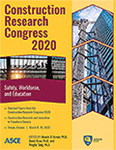Construction Research Congress 2020
Evaluating the Effectiveness of Worker Safety Vests on Drivers’ Visual Attention
Publication: Construction Research Congress 2020: Safety, Workforce, and Education
ABSTRACT
Vehicular traffic in construction work zones presents multiple threats to worker safety on roadway projects. One method to ensure workers are seen by passing vehicles is for workers to don high-visibility apparel. Although research suggests that safety vests may increase the conspicuity of construction workers, no research specifically examines the effects of the presence of safety vests on driver’s visual attention in construction work zones. To test this, 16 participants were fitted with wearable eye tracking glasses and were asked to navigate a series of simulated construction work zones on an interactive driving simulator. Each participant was randomly assigned to two simulated environments, one in which workers were wearing safety vests and one in which workers were not. A paired-sample t test was used to test for a significant difference between groups in the mean number of construction workers gazed upon by the participants. The results suggest that workers who don safety apparel in construction work zones are more frequently observed by drivers in simulated environments. This research adds to the body of knowledge by empirically validating the use of high visibility apparel and builds a framework for employing eye tracking technology in both simulated and real world environments.
Get full access to this article
View all available purchase options and get full access to this chapter.
REFERENCES
ANSI/International Safety Equipment Association (ISEA) (2015). American national standard for high-visibility safety apparel and headwear, ANSI/ISEA 107–2015, Washington, DC., United States.
Bass, S. B., Gordon, T. F., Gordon, R., & Parvanta, C. (2016). Using eye tracking and gaze pattern analysis to test a “dirty bomb” decision aid in a pilot RCT in urban adults with limited literacy. BMC medical informatics and decision making, 16 (1), 1-13.
Bedard, M. B., Parkkari, M., Weaver, B., Riendeau, J., & Dahlquist, M. (2010). Assessment of driving performance using a simulator protocol: Validity and reproducibility. American Journal of Occupational Therapy, 64, 336–340.
Blomberg, R. D., Hale, A., & Preusser, D. F. (1986). Experimental evaluation of alternative conspicuity-enhancement techniques for pedestrians and bicyclists. Journal of Safety Research, 17(1), 1-12.
Bryden, J. E., & Andrew, L. (1999). Serious and fatal injuries to workers on highway construction projects. Transportation Research Record, 1657, 42 – 47.
Cook, S., Quigley, C., & Clift, L. (1999). Motor vehicle conspicuity: an assessment of the contribution of retro reflective and fluorescent materials.
Dickerson, A., Eaker, M., Clark, B., & Gartz, R. (2018). Using eye tracking technology to explore scanning abilities of old & young adults on interactive driving simulators. Innovation in Aging, 2(Suppl 1), 681.
Duchowski, A. (2007). Eye tracking methodology: Theory and practice, Springer Science and Business Media, Dordrecht, Netherlands
Goldberg, J. H., & Kotval, X. P. (1999). Computer interface evaluation using eye movements: Methods and constructs. International Journal of Industrial Ergonomics, (24): 631-645
Golovina, O., Teizer, J., & Pradhananga, N. (2016). Heat map generation for predictive safety planning: Preventing struck-by and near miss interactions between workers-on-foot and construction equipment. Automation in construction, 71, 99-115.
Henderson, J. M., & Hollingworth, A. (1998). Eye movements during scene viewing: An overview. In G. Underwood (Ed.) Eye guidance in reading and scene perception (pp. 269-294).
KUN, A.L., PAEK, T., MEDENICA, Z., MEMAROVIC, N., AND PALINKO, O. 2009. Glancing at personal navigation devices can affect driving: experimental results and design implications. Proc
Lee, H. C. (2006). Virtual driving tests for older adult drivers? British Journal of Occupational Therapy, 69, 138–141.
Luoma, J., Schumann, J., & Traube, E. C. (1996). Effects of retroreflector positioning on nighttime recognition of pedestrians. Accident Analysis & Prevention, 28(3), 377-383.
Mohan, S., & Zech, W. C. (2005). Characteristics of worker accidents on NYSDOT construction projects. Journal of Safety Research, 36(4), 353-360.
Ore, T., & Fosbroke, D. (1997). Motor vehicle fatalities in the United States construction industry. Accident Analysis and Prevention, 29(5),613 – 626
Palinko, O., Kun, A. L., Shyrokov, A., & Heeman, P. (2010, March). Estimating cognitive load using remote eye tracking in a driving simulator. In Proceedings of the 2010 symposium on eye-tracking research & applications (pp. 141-144). ACM.
Pratt, S., Fosbroke, D., & Marsh, S. (2001, April). Building Safer Highway Work Zones: Measures to Prevent Worker Injuries from Vehicles and Equipment (Publication No. 2001-128). Washington, DC’ NIOSH, Department of Health and Human Services.
Rashid, S., Soo, S. T., Sivaji, A., Naeni, H. S., & Bahri, S. (2013). Preliminary usability testing with eye tracking and FCAT analysis on occupational safety and health websites. Procedia-Social and Behavioral Sciences, (97): 737-744.
Rogé, J., Laurent, S., Ndiaye, D., Aillerie, I., & Vienne, F. (2018). Does a yellow jacket enhance cyclists’ sensory conspicuity for car drivers during daylight hours in an urban environment? Safety Science.
Shechtman, O., Classen, S., Awadzi, K., & Mann, W. (2009). Comparison of driving errors between on-the-road and simulated driving assessment: A validation study. Traffic Injury Prevention, 10,379–385.
Systems Technology. (n.d.). STISIM Drive (Version 2) [Computer software]. Hawthorne, CA: Author.
TOBII. (2019a). Recording with Tobii Pro Glasses 2. Retrieved June 24, 2019, from https://www.tobiipro.com/learn-and-support/learn/steps-in-an-eye-tracking-study/run/recording-with-tobii-pro-glasses-2/
TOBII. (2019b). Working with dynamic stimuli in the AOI tool. Retrieved June 24, 2019, from https://www.tobiipro.com/learn-and-support/learn/steps-in-an-eye-tracking-study/data/analyzing-dynamic-stimuli-with-the-aoi-tool/
Tuttle, Stephanie J., James R. Sayer, and Mary Lynn Buonarosa. "The conspicuity of first-responder safety garments." Journal of safety research40.3 (2009): 191-196.
Information & Authors
Information
Published In
Construction Research Congress 2020: Safety, Workforce, and Education
Pages: 105 - 113
Editors: Mounir El Asmar, Ph.D., Arizona State University, David Grau, Ph.D., Arizona State University, and Pingbo Tang, Ph.D., Arizona State University
ISBN (Online): 978-0-7844-8287-2
Copyright
© 2020 American Society of Civil Engineers.
History
Published online: Nov 9, 2020
Published in print: Nov 9, 2020
Authors
Metrics & Citations
Metrics
Citations
Download citation
If you have the appropriate software installed, you can download article citation data to the citation manager of your choice. Simply select your manager software from the list below and click Download.
